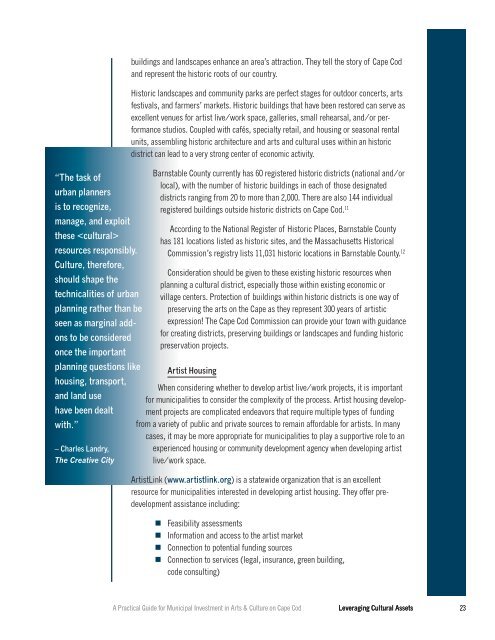Leveraging Cultural Assets for Economic Development - Cape Cod ...
Leveraging Cultural Assets for Economic Development - Cape Cod ...
Leveraging Cultural Assets for Economic Development - Cape Cod ...
- No tags were found...
You also want an ePaper? Increase the reach of your titles
YUMPU automatically turns print PDFs into web optimized ePapers that Google loves.
“The task ofurban plannersis to recognize,manage, and exploitthese resources responsibly.Culture, there<strong>for</strong>e,should shape thetechnicalities of urbanplanning rather than beseen as marginal addonsto be consideredonce the importantplanning questions likehousing, transport,and land usehave been dealtwith.”– Charles Landry,The Creative Citybuildings and landscapes enhance an area’s attraction. They tell the story of <strong>Cape</strong> <strong>Cod</strong>and represent the historic roots of our country.Historic landscapes and community parks are perfect stages <strong>for</strong> outdoor concerts, artsfestivals, and farmers’ markets. Historic buildings that have been restored can serve asexcellent venues <strong>for</strong> artist live/work space, galleries, small rehearsal, and/or per<strong>for</strong>mancestudios. Coupled with cafés, specialty retail, and housing or seasonal rentalunits, assembling historic architecture and arts and cultural uses within an historicdistrict can lead to a very strong center of economic activity.Barnstable County currently has 60 registered historic districts (national and/orlocal), with the number of historic buildings in each of those designateddistricts ranging from 20 to more than 2,000. There are also 144 individualregistered buildings outside historic districts on <strong>Cape</strong> <strong>Cod</strong>. 11According to the National Register of Historic Places, Barnstable Countyhas 181 locations listed as historic sites, and the Massachusetts HistoricalCommission’s registry lists 11,031 historic locations in Barnstable County. 12Consideration should be given to these existing historic resources whenplanning a cultural district, especially those within existing economic orvillage centers. Protection of buildings within historic districts is one way ofpreserving the arts on the <strong>Cape</strong> as they represent 300 years of artisticexpression! The <strong>Cape</strong> <strong>Cod</strong> Commission can provide your town with guidance<strong>for</strong> creating districts, preserving buildings or landscapes and funding historicpreservation projects.Artist HousingWhen considering whether to develop artist live/work projects, it is important<strong>for</strong> municipalities to consider the complexity of the process. Artist housing developmentprojects are complicated endeavors that require multiple types of fundingfrom a variety of public and private sources to remain af<strong>for</strong>dable <strong>for</strong> artists. In manycases, it may be more appropriate <strong>for</strong> municipalities to play a supportive role to anexperienced housing or community development agency when developing artistlive/work space.ArtistLink (www.artistlink.org) is a statewide organization that is an excellentresource <strong>for</strong> municipalities interested in developing artist housing. They offer predevelopmentassistance including:n Feasibility assessmentsn In<strong>for</strong>mation and access to the artist marketn Connection to potential funding sourcesn Connection to services (legal, insurance, green building,code consulting)A Practical Guide <strong>for</strong> Municipal Investment in Arts & Culture on <strong>Cape</strong> <strong>Cod</strong> <strong>Leveraging</strong> <strong>Cultural</strong> <strong>Assets</strong> 23
















